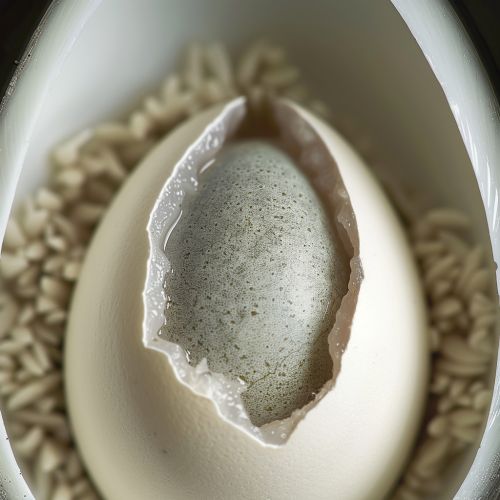Amniotic egg
Introduction
The Amniotic egg is a significant evolutionary adaptation that allowed the ancestors of modern reptiles, birds, and mammals to reproduce on land. This type of egg, which is also known as a cleidoic egg, is characterized by its specialized membranes that facilitate the survival of the embryo inside.
Evolutionary Significance
The development of the amniotic egg represents a crucial turning point in the history of life on Earth. Before its evolution, animals were largely bound to aquatic environments for reproduction, as their eggs lacked the necessary structures to prevent desiccation on land. The emergence of the amniotic egg allowed the ancestors of today's amniotes, which include reptiles, birds, and mammals, to break free from the water and colonize terrestrial environments.
Structure and Composition
The amniotic egg is composed of several layers, each with a specific function that contributes to the survival and development of the embryo.
Shell
The outermost layer of the amniotic egg is the shell. In birds and some reptiles, this shell is hard and calcified, providing physical protection to the embryo inside. In contrast, the eggshells of many reptiles and all mammals are leathery and flexible.
Membranes
Beneath the shell are several specialized membranes. The outermost of these is the chorion, which facilitates gas exchange between the embryo and the surrounding environment. Inside the chorion is the amnion, a fluid-filled sac that provides a protective, cushioning environment for the developing embryo. The yolk sac supplies the embryo with nutrients from the yolk, while the allantois serves as a reservoir for waste products.
Albumen
The albumen, or egg white, is a protein-rich substance that provides additional nutrients for the embryo. It also serves to cushion the embryo and maintain a consistent temperature within the egg.
Reproduction and Development
Amniotic eggs are typically laid outside the body, although some animals, such as certain species of sharks and snakes, retain the eggs inside the body until they hatch, a process known as ovoviviparity. In mammals, the amniotic egg is retained within the body and develops into a structure known as the placenta, which facilitates nutrient and waste exchange between the mother and the developing embryo.
The development of the embryo within the amniotic egg is a complex process that involves a series of well-coordinated morphological changes. This process, known as embryogenesis, begins with the fertilization of the egg and ends with the hatching or birth of the offspring.
Amniotes
The term "amniotes" is used to refer to the group of animals that produce amniotic eggs. This group includes all reptiles, birds, and mammals. The ability to reproduce using amniotic eggs has allowed these animals to colonize a wide range of terrestrial environments, from deserts to polar regions.
See Also


